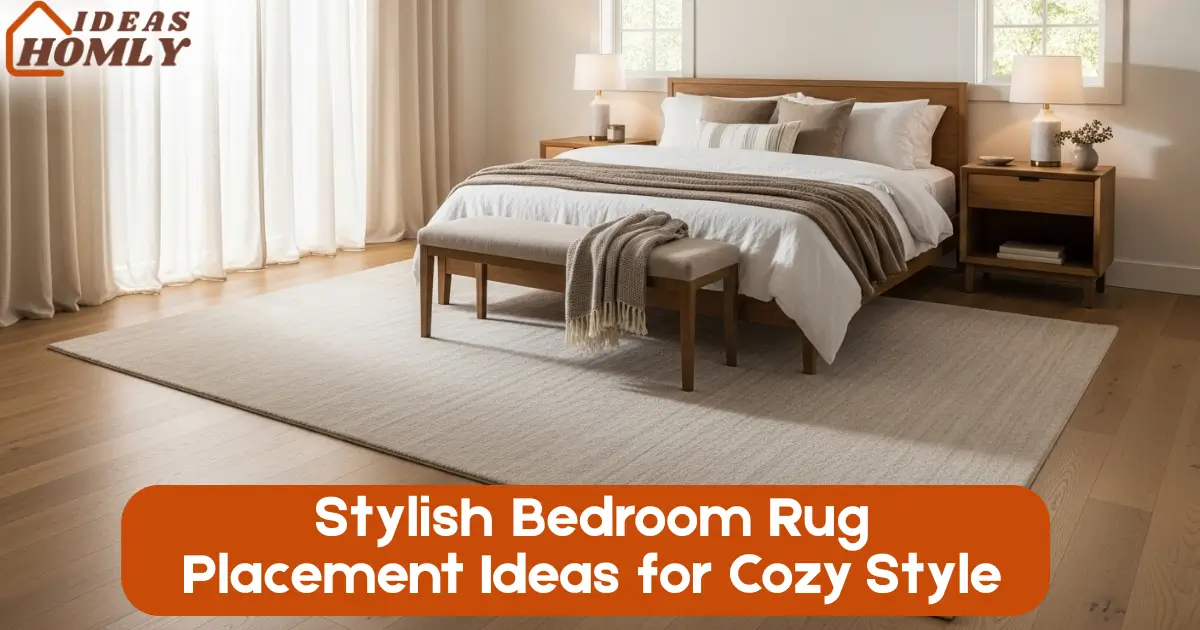Let me be honest nothing ruins a cozy vibe faster than cold feet hitting a bare floor in the morning. That’s why choosing the right bedroom rug placement is way more important than people think.
You can have the softest bedding, the prettiest curtains, even Pinterest-worthy wall art but if your floors feel empty, the room lacks soul. I’ve been playing around with rug layouts for years, and I’ve learned one thing: where you place your rug can completely change the look and feel of your bedroom.
So, if you’re wondering where should a rug go in a bedroom?, you’re in the right place. I’m going to discuss smart, stylish rug placement ideas that bring in warmth, balance, and yep cozy style without blowing your budget or making your room feel cramped.
Why Rug Placement Matters in a Bedroom?
Rugs aren’t just for warmth they anchor your space. Think of them as the visual glue that holds your room together.
From balancing furniture to softening foot traffic, the right rug layout in bedroom can make a small room feel larger, or a large room feel more inviting.
Plus, if you live in a rental (like I used to), rugs are the easiest way to define your space without making permanent changes. Been there, done that, saved my deposit.
Let’s talk about my top 4 rug placement methods that I keep coming back to because they actually work.
1. Full Area Rug Under the Bed
Ah yes, the classic. This one’s a personal favorite when I want the room to feel finished and luxurious.
Here’s how it works:
You place a large rug under the bed, big enough so it extends at least 18–24 inches beyond the sides and foot. It frames the bed beautifully and adds a plush touch when you get out of bed.
This layout gives the room a balanced look, especially if your bed is the focal point (which, let’s be honest, it usually is). I usually recommend this setup if you’ve got the space and especially if your bed floats in the center rather than being pushed to a corner.
Why I love it:
- It makes a statement without overwhelming the room.
- It visually ties together nightstands, bed, and bench (if you have one).
- It adds that cozy, hotel-like comfort we all secretly crave.
Helpful tip:
Don’t go too small with the rug. A tiny rug under a big bed just looks…awkward. For a queen bed, I go for an 8×10 rug, and for a king bed, at least 9×12. Trust me on this one.
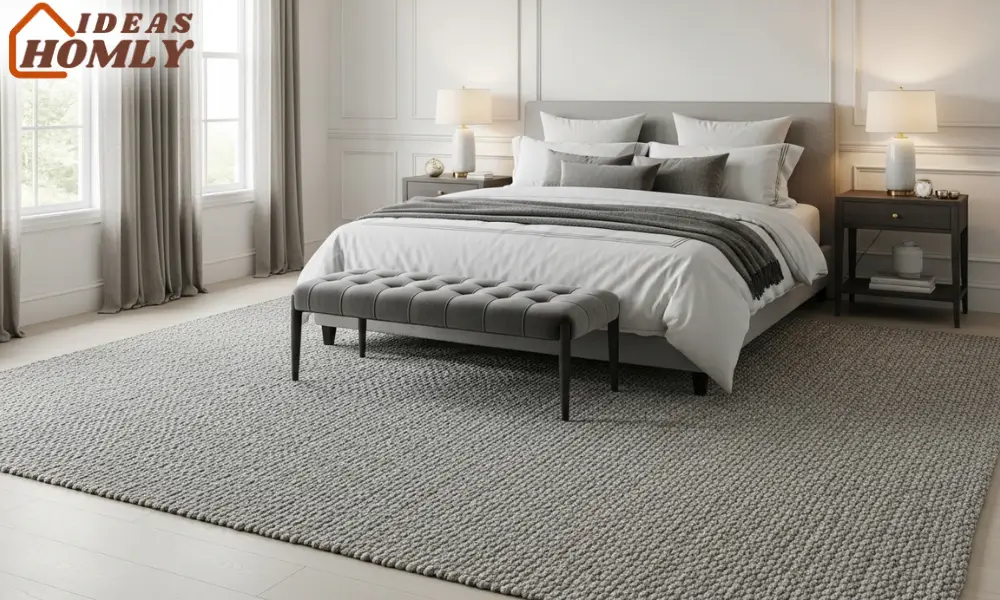
2. Runner Rugs on Each Side
When I moved into a smaller apartment, I had to get creative. That’s when I discovered the magic of bedroom runner rugs.
Instead of a single large area rug, I placed two long runners on either side of the bed. It added comfort, texture, and symmetry all without needing a rug the size of a yoga studio.
This is perfect if you have:
- Narrow spaces on each side of the bed
- Wall-to-wall carpet but still want that layered texture
- Pets who love soft surfaces but tend to avoid larger rugs (my cat’s picky, okay?)
These side rugs are super easy to clean or swap out. And if you’re on a budget? You can find gorgeous runners for half the price of large area rugs.
My sizing for runners:
| Bed Size | Runner Size (Each Side) |
|---|---|
| Twin | 2’ x 6’ |
| Queen | 2.5’ x 7’ |
| King | 3’ x 8’ |
Choose runners that match or complement your bedding or curtains. You’ll be surprised how much style those narrow strips can add.
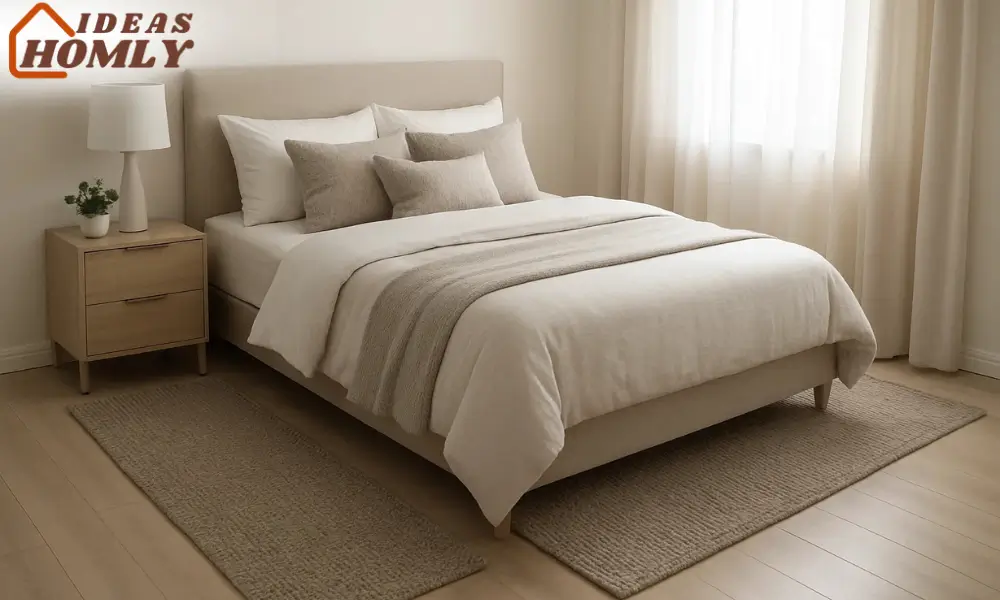
3. Sheepskin or Faux Fur Rug at the Foot of the Bed
There’s something about a faux fur or sheepskin rug that screams cozy without actually screaming. It’s soft, inviting, and instantly makes your bedroom feel like a warm hug.
I started using a sheepskin rug at the foot of my bed years ago when I couldn’t commit to a full area rug. Turns out, it’s the perfect solution for small rooms or minimalist setups.
Why it works:
- It adds a soft texture right where your feet land.
- It draws attention to the bed, grounding it without covering the whole floor.
- It’s budget-friendly and ridiculously easy to switch out by season or mood.
You can place a single fur rug horizontally across the foot of your bed or go bold with two small rugs on both sides. I sometimes rotate mine diagonally to give it a more natural, effortless look. (Yes, I’m that extra.)
And don’t worry faux fur looks just as luxe and is cruelty-free. Bonus: It’s easier to clean, especially if you live with pets who believe every rug is their throne.
Styling tip:
Pick a fur rug that complements your bedroom’s color palette. White, cream, blush, and grey tones blend easily and elevate the cozy factor.
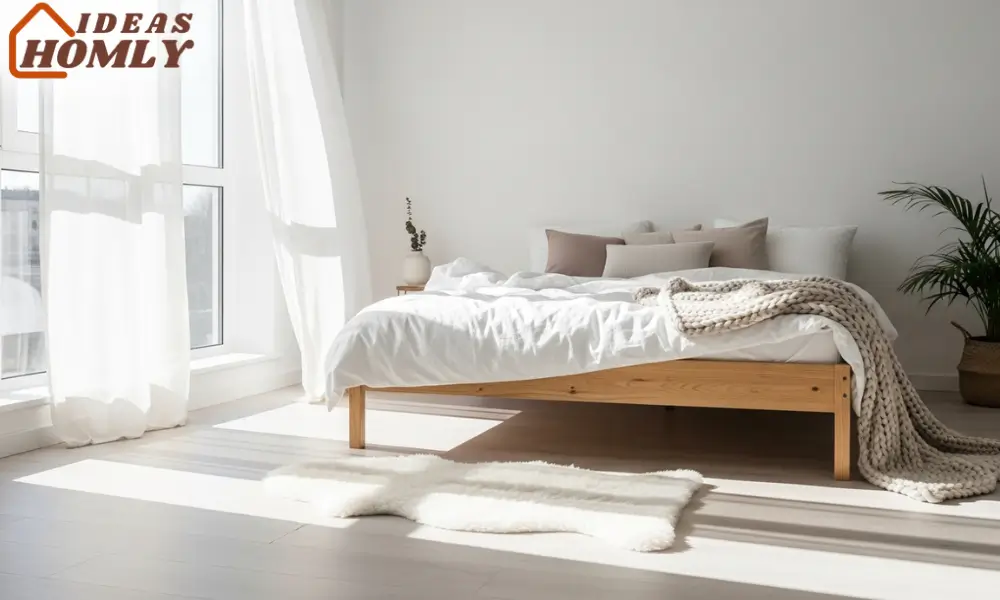
4. Rug to Define a Seating Nook
Not every bedroom has space for a seating area, but if you’re lucky enough to squeeze one in even if it’s just a chair and ottoman, you need a rug to define it.
I learned this the hard way. Without a rug, my little reading corner felt like random furniture floating in space. One small rug later? It became a true cozy corner.
How to do it right:
- Use a small area rug (think 4×6 or 5×7) to anchor your seating area.
- Make sure all legs of your chair and table sit on the rug.
- Match the rug’s tone to your bedding or wall color to keep things cohesive.
Whether it’s a corner armchair, a bench by the window, or a beanbag for your kids (or you, no judgment), a well-placed rug grounds the furniture and adds visual balance.
And here’s the secret: Layering textures is everything. I sometimes throw a chunky knit blanket over the chair to match the rug’s softness. It instantly creates a layered, styled look that feels thoughtful without being over-designed.
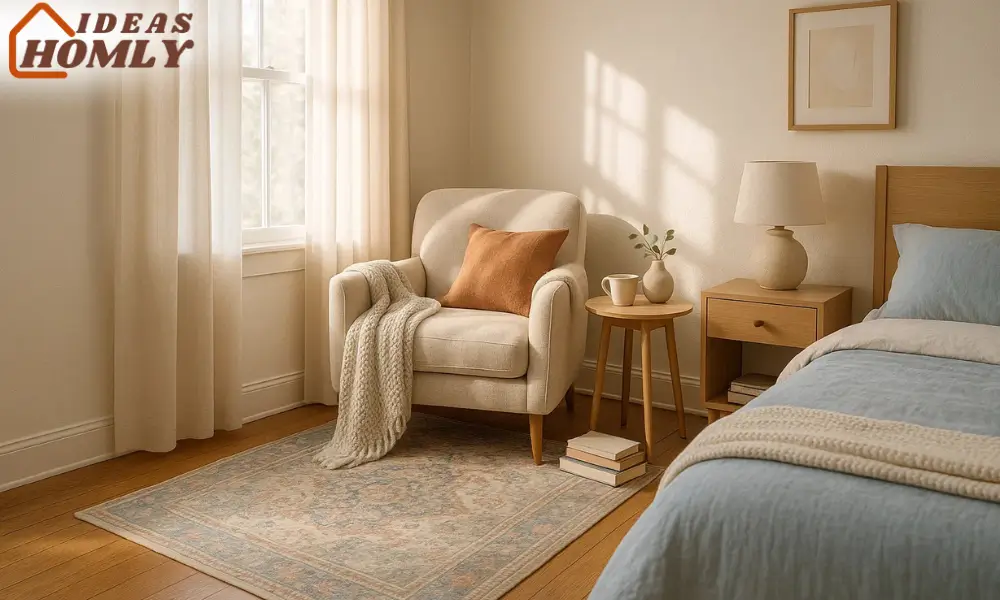
Best Rug Sizes by Bed Type
I always get asked: “What size rug should I use under my bed?” So here’s a simple table I’ve put together based on my own experience and lots of trial-and-error:
| Bed Size | Ideal Rug Size (Full Area) | Ideal Runner Size (Each Side) | Notes |
|---|---|---|---|
| Twin | 5×8 or 6×9 | 2×6 | Great for kids or guest rooms |
| Full | 6×9 | 2.5×6 | Allows 18–24″ rug reveal |
| Queen | 8×10 | 2.5×7 | Balanced look with nightstands |
| King | 9×12 | 3×8 | Luxurious and symmetrical |
| California King | 10×14 | 3×8 | For extra spacious bedrooms |
Quick tip: If your rug only covers part of the bed, make sure it starts just in front of the nightstands. That way, it still feels centered and deliberate.
Conclusion
After years of experimenting, moving furniture around (and pulling a few muscles along the way), I’ve realized one thing, the way you place your bedroom rug matters more than you’d think.
Whether you go for a full area rug under the bed, stylish runners on the sides, a soft faux fur at the foot, or a cozy nook rug in the corner, each option brings its own charm and function. I’ve used all four styles at different stages of my life and trust me, they all work when styled intentionally.
Remember, your rug isn’t just decor it’s comfort. It’s warmth on a winter morning. It’s style that ties the room together without saying a word.
So take your time, measure twice, and let your rug placement reflect the cozy, creative, and intentional home you’re building, one step (and one soft rug) at a time.
FAQs
For a queen bed, I always recommend an 8×10 rug. This size gives you enough coverage on all sides, especially if you want that soft underfoot feel in the morning.
Make sure the rug extends at least 18–24 inches beyond the bed edges to create visual balance. You can also use runners on each side if your room is narrow.
Yes, absolutely and I’ve done it myself many times. Layering a rug over carpet is a great way to define space, add texture, and make the room feel more intentional.
Just choose a rug with a flat or low pile and use a rug pad to prevent slipping or bunching. It works especially well in rentals or older homes with dull carpet.
Not necessarily. I usually make sure at least the front legs of large pieces (like the bed or nightstands) sit on the rug. This helps anchor the space without needing an oversized rug.
In seating nooks, I aim to have all furniture legs on the rug for a more cohesive look but again, no hard rules here. Do what works for your space.
That one drove me crazy until I found the solution; rug pads. A good non-slip rug pad will keep your rug in place, protect your floors, and even make the rug feel cushier underfoot. If you’re using runners, look for gripper strips or corner anchors. Trust me, your toes (and your sanity) will thank you.

